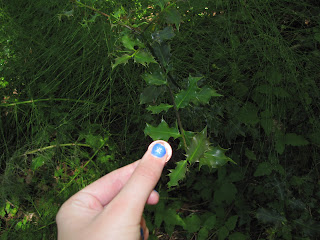Adaptation of an animal: An adaptation is a beneficial trait that has evolved by means of natural selection. Feathers like this one are adaptations that have evolved to help birds fly and keep warm, dry, and camouflaged.

Adaptation of a plant: An adaptation is a beneficial trait that has evolved by means of natural selection. The leaves on this holly have evolved sharp points in order to protect itself from being eaten by herbivores.
Autotroph: Autotrophs are organisms that can make their own food through photo- or chemosynthesis, and do not need a living energy or carbon source. This seaweed, as a green algae, obtains energy through photosynthesis, making it an autotroph.
Bilateral symmetry: In this type of symmetry, a single plane will divide the organism into two roughly identical halves. In this sand dollar, a vertical line of symmetry is clearly visible. Both sides are basically identical.
Exoskeleton: A skeleton in the form of a hard outer shell that protects and supports an organism. They are most commonly found on insects and crustaceans. This crab has an exoskeleton coating its body rather than an inner skeleton.
Frond: A frond is a large, divided leaf, like this fern.
Gymnosperm cone (female): This is a woody female pine cone. It contained ovules beneath the scales, which, when fertilized, became seeds that dispersed when the cone opened.
Gymnosperm leaf: These are the leaves of a red cedar, distinctive by its flat sprays and scale-like texture. Red cedars bear small, brown cones enclosing seeds, the identifying trait of a gymnosperm.
Heterotroph: This dog, like all animals, cannot make its own food and must eat in order to obtain energy. This makes it a heterotroph.
Modified leaf: These are blackberry flowers. They carry petals, which are leaves modified to be colored and somewhat unusually shaped in order to attract pollinators.
Detritovore: This is a small (dead) millipede. Millipedes eat dead leaves and other decaying plant matter. Detritovores eat that kind of detritus. It is a detritovore.
Population: A population is all the organisms that both belong to the same group or species and live in the same geographical area. These four pictures display the oyster bed at Kopachuck beach, which is a large number of oysters in the same area and is therefore a population.
Radial symmetry: Radially symmetric organisms are roughly identical on any horizontal plane. This plant is round and just about the same on any point in its length. It has no left or right sides.
Seed dispersal (wind): This maple seed has wings (samara) that caught the wind and caused it to flutter to the ground some distance away from the tree.
Vestigial structures: Vestigial structures have lost their purpose and exist as a useless feature of the organism. As dandelions reproduce asexually, their flowers have no remaining purpose.
Asexual reproduction: Reproduction where offspring arise from a single parent, and inherit the genes of that parent only. Dandelions reproduce by apomixis, a variation of asexual reproduction, where seeds are still present, albeit without fertilization.
Organisms in different kingdoms:
Plant: Organisms with cell walls, cellulose, and that photosynthesize, like the blackberry-ish vine in the background.
Animal: My hand is in this photo. I, like all animals, am heterotrophic, motile, and lack cell walls.
Fungi: Organisms that are heterotrophs and have cell walls containing chitin, like the one growing (and feeding) on the dead log pictured here.




















On "Radial Symmetry": You said there is no "left or right side". Is that what you mean? I feel like radial symmetry would be better explained as "the right side is indistinguishable from the left", as there is technically a left and right side, any way you cut it. Good pictures!
ReplyDeleteWhat are other types of of gymnosperms besides red cedar? Are cedar trees the only gymnosperms?- Kristen East
ReplyDelete